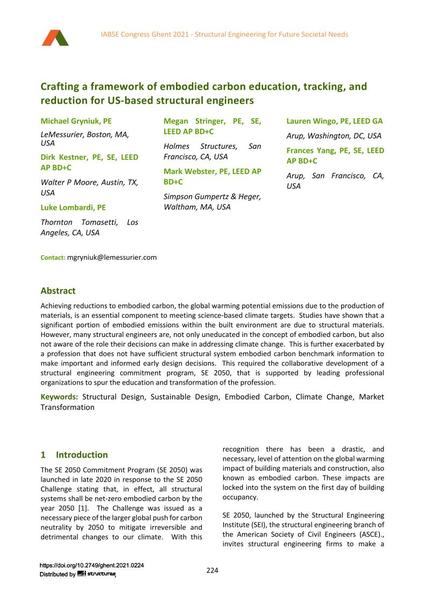Crafting a framework of embodied carbon education, tracking, and reduction for US-based structural engineers

|
|
|||||||||||
Bibliographic Details
| Author(s): |
Michael Gryniuk
(LeMessurier, Boston, MA, USA)
Dirk Kestner (Walter P Moore, Austin, TX, USA) Luke Lombardi (Thornton Tomasetti, Los Angeles, CA, USA) Megan Stringer (Holmes Structures, San Francisco, CA, USA) Mark Webster (Simpson Gumpertz & Heger, Waltham, MA, USA) Lauren Wingo (Arup, Washington, DC, USA) Frances Yang (Arup, San Francisco, CA, USA) |
||||
|---|---|---|---|---|---|
| Medium: | conference paper | ||||
| Language(s): | English | ||||
| Conference: | IABSE Congress: Structural Engineering for Future Societal Needs, Ghent, Belgium, 22-24 September 2021 | ||||
| Published in: | IABSE Congress Ghent 2021 | ||||
|
|||||
| Page(s): | 224-231 | ||||
| Total no. of pages: | 8 | ||||
| DOI: | 10.2749/ghent.2021.0224 | ||||
| Abstract: |
Achieving reductions to embodied carbon, the global warming potential emissions due to the production of materials, is an essential component to meeting science-based climate targets. Studies have shown that a significant portion of embodied emissions within the built environment are due to structural materials. However, many structural engineers are, not only uneducated in the concept of embodied carbon, but also not aware of the role their decisions can make in addressing climate change. This is further exacerbated by a profession that does not have sufficient structural system embodied carbon benchmark information to make important and informed early design decisions. This required the collaborative development of a structural engineering commitment program, SE 2050, that is supported by leading professional organizations to spur the education and transformation of the profession. |
||||
| Keywords: |
structural design climate change sustainable design embodied carbon Market Transformation
|
||||
| Copyright: | © 2021 International Association for Bridge and Structural Engineering (IABSE) | ||||
| License: | This creative work is copyrighted material and may not be used without explicit approval by the author and/or copyright owner. |
||||
